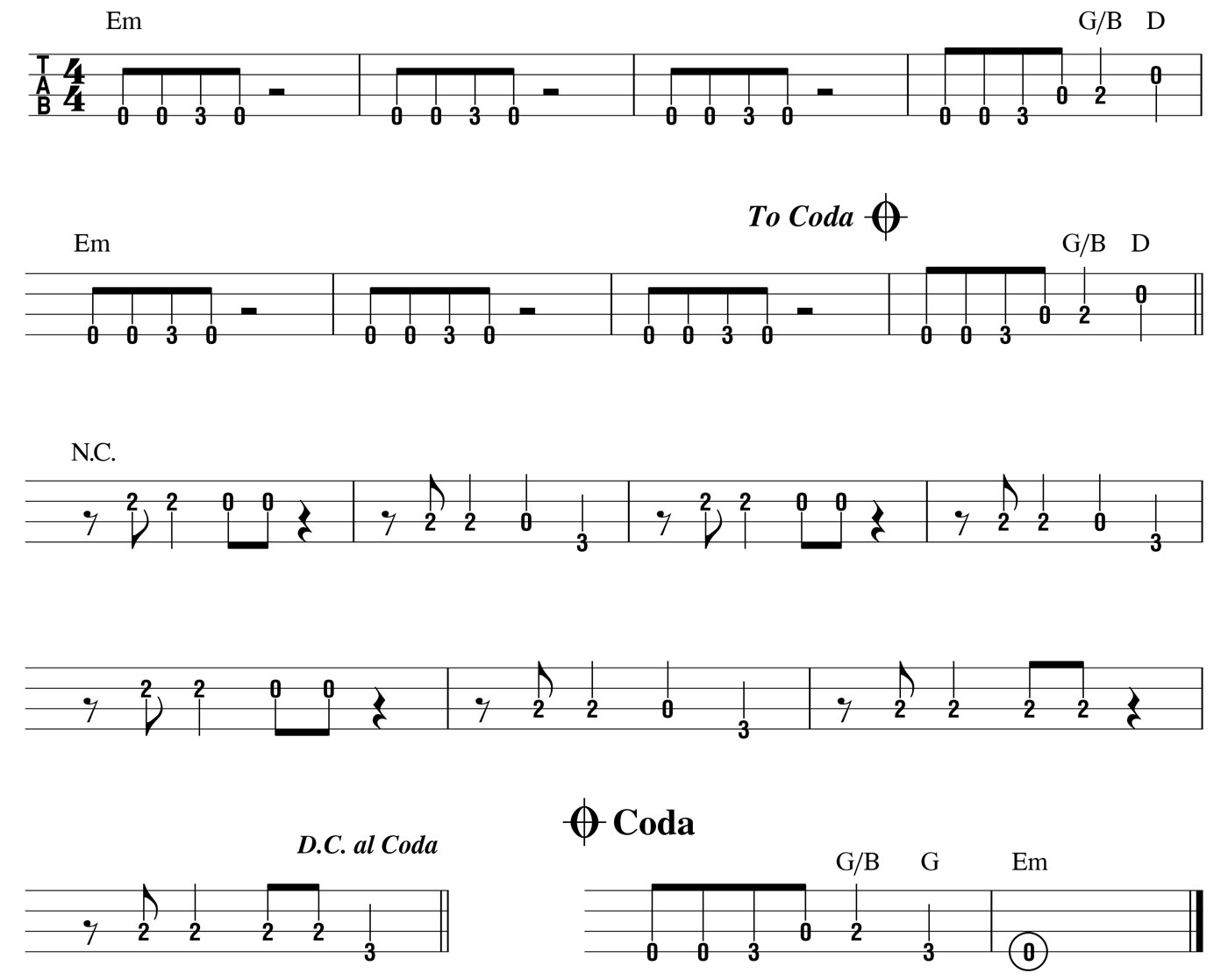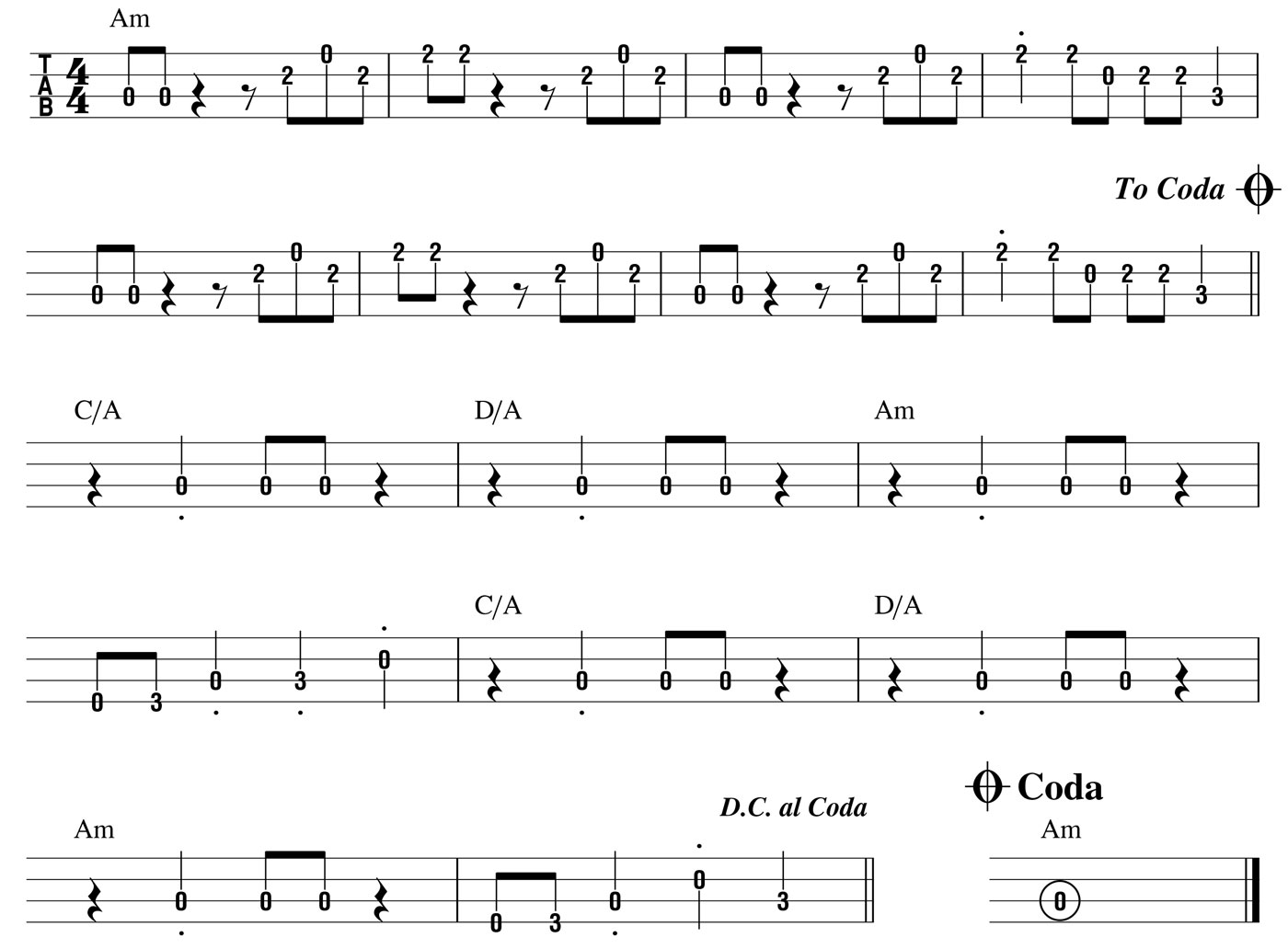Chapter 7
Minor Pentatonic Scales
The darker, more angst-ridden sibling of the major pentatonic scale is the minor pentatonic scale. It’s a five-note scale, as well, but it’s based on the minor scale, which we haven’t looked at yet (we will in Chapter 9). However, that won’t stop us, as we know what we need to know.
The minor pentatonic scale is created by omitting the second and sixth notes from the minor scale. It’s often used in hard rock, blues, and funk styles, among others.
E Minor Pentatonic Scale
The E minor pentatonic scale can be easily handled in open position. Here’s how it looks (the open G note and A note on string 1 are included because they’re accessible within this scale form):
E Minor Pentatonic Scale in Open Position

This scale should look familiar; it’s an awful lot like the G major pentatonic scale, isn’t it? There’s good reason for that: E minor is the relative minor of G major. This means that the key of E minor shares the same key signature as G major: one sharp (F). Similarly, the G major scale (or G major pentatonic scale) shares the exact same notes as the E minor scale (or E minor pentatonic scale). The only difference is that, in E minor, the note E is treated as the tonic, whereas in G major, the note G is treated as the tonic.
Let’s try it out in a few examples. Remember to make the rests distinct!
Example 33

Example 34

A Minor Pentatonic Scale
Now let’s check out the A minor pentatonic scale, which looks just like E minor pentatonic, only up a string set (the open E note and G note on string 4 are included because they’re accessible within this scale form).

In case you were wondering: yes, this is the relative minor of C major. That’s why it’s so similar to the C major scale.
Here’s how the A minor pentatonic scale sounds in some grooves. Be sure to use your fret hand to keep the open G string from ringing out in this first one.
Example 35

Here we have staccato notes again. Remember to plant your right-hand thumb on the A string to stop it from ringing when you pluck the high A on beat 2. Also remember to rake your plucking fingers on beats 3–4!
Example 36

The notes below the tonic (open E and G notes on string 4) can sound really great when you include them.
Example 37

Song 8: E Minor Pentatonic Riff Rock
Here’s a rocking tune in E minor that uses the E minor pentatonic scale exclusively. This one sounds best with a pick, so dig in! By the way: “N.C.” (measure 9) stands for “no chord.” An instrument shouldn’t play a chord here—just a riff. The “G/B” symbol in measure 4 is a slash chord. This simply means that the bass is playing a note other than the root of the chord. In this case, the guitars are playing a G chord, but we’re playing a B note. The B note is part of the G chord, however, which is why it doesn’t sound terribly odd. We’ll look more closely at that type of thing later in the book.
Example 38
E Minor Pentatonic Riff Rock

Song 9: A Minor Pentatonic R&B Groove
This song features a cool-sounding groove that uses our A minor pentatonic scale. Here are a few things to remember when working this one up:
- Use the rake technique when applicable. At the end of measure 2, you’ll rake all the way from the G string to the A string with one smooth stroke!
- Note the staccato mark in measures 4 and 8 and the eight measures that follow.
- Tap your foot along while you play, as this will help to prevent you from rushing the beat.
- At the end of measures 1, 3, 5, and 7, you move from fret 2 of string 2 to fret 2 of string 1. When you do this, instead of refretting, simply “roll” your fret-hand finger from string 2 to string 1. You’ll be playing string 1 with the pad of your finger instead of the tip. This technique will come in very handy as you move forward, so spend some time with it to make sure it feels natural. Consequently, if the order of the notes were reversed and you played string
1 before string 2, you’d need to plan ahead by fretting string 1 with the pad of your finger so you could then roll over to string 2 with the tip.
Example 39
A Minor Pentatonic R&B Groove
